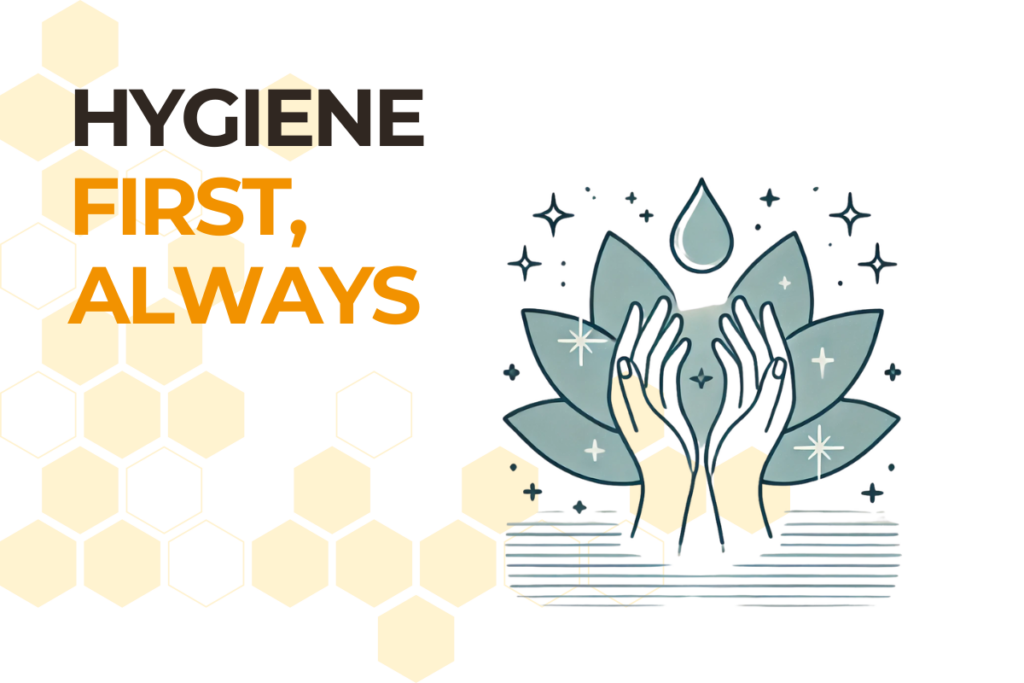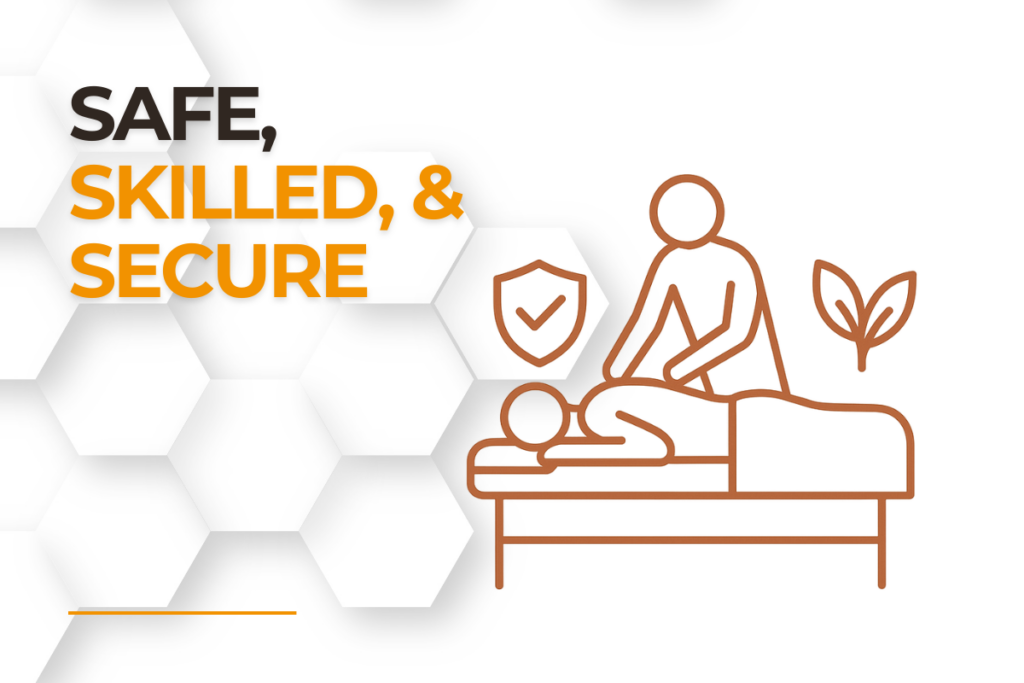Creating a Safe and Trustworthy Environment for Clients and Therapists
Prioritizing health and safety in a massage therapy clinic is not just about meeting industry standards—it’s about creating a secure and welcoming environment where clients feel confident in your care and therapists can work without risk of injury. From maintaining rigorous hygiene protocols to implementing injury prevention strategies and preparing for emergency situations, every aspect of clinic operations should be designed to minimize risks and promote well-being. A lapse in these crucial standards can lead to serious consequences, including potential health hazards, legal liabilities, reputational damage, and even loss of business.
Beyond compliance, a proactive approach to health and safety also enhances client retention, boosts therapist satisfaction, and strengthens the clinic’s overall professionalism. In this article, we’ll explore essential health and safety best practices for massage therapy clinics, covering infection control, therapist ergonomics, risk management, and emergency preparedness—ensuring a safer and more resilient practice for all.
Prioritizing Hygiene and Sanitation Standards
Implementing Rigorous Infection Control Measures
A clean and sanitized massage therapy clinic is vital for health and safety. Given the close-contact nature of massage therapy, following strict hygiene practices is crucial.
- Wash hands before and after every session using antibacterial soap for at least 20 seconds.
- Disinfect massage tables, tools, and high-touch surfaces between appointments.
- Use disposable face cradles or replace linens after each session to prevent cross-contamination.
- Ensure proper ventilation to reduce airborne contaminants and maintain a healthy environment.
Creating a Cleaning and Maintenance Schedule
A structured cleaning routine is necessary to ensure health and safety in a massage therapy clinic.
- Develop daily, weekly, and monthly cleaning checklists to ensure thorough sanitation.
- Assign staff responsibilities for maintaining cleanliness and organization.
- Use professional-grade disinfectants to eliminate bacteria, viruses, and fungi.
Example: A clinic in Edmonton reassured clients by visibly displaying their cleaning schedule, enhancing trust in their commitment to health and safety.

Preventing Therapist Injuries and Work-Related Strain
Ensuring Proper Body Mechanics
Therapists must prioritize their own health and safety by practicing proper body mechanics to avoid repetitive strain injuries.
- Adjust massage tables to an ergonomic height to reduce unnecessary bending.
- Engage core muscles and maintain proper posture while applying pressure.
- Use forearms and elbows instead of thumbs to prevent overuse injuries.
- Perform daily stretching and strengthening exercises to improve endurance.
Managing Workload to Reduce Burnout
Scheduling plays a crucial role in maintaining therapist health and safety.
- Limit deep tissue sessions per day to prevent strain and fatigue.
- Schedule short breaks between clients for proper recovery.
- Encourage therapists to listen to their bodies and adjust techniques accordingly.
Conducting Thorough Client Health Assessments
Obtaining Complete Health Histories
Accurate health intake forms are essential for assessing client health and safety.
- Require clients to disclose medical conditions, medications, and past injuries before treatment.
- Regularly update health forms to reflect changes in client conditions.
- Maintain digital records for compliance and accessibility.
Recognizing Red Flags and Adjusting Treatments
Some conditions require treatment modifications to ensure health and safety in a massage therapy clinic.
- Avoid deep tissue work for clients on blood thinners to prevent excessive bruising.
- Modify techniques for clients with osteoporosis to reduce fracture risks.
- Refer clients to medical professionals when necessary.
Example: A therapist detected an undisclosed blood clot risk during intake, preventing potential complications by modifying treatment.
Maintaining Air Quality and Allergen Control
Investing in Proper Ventilation Systems
Clean air is a fundamental aspect of maintaining health and safety in a massage therapy clinic.
- Use HEPA air filters to minimize allergens and airborne particles.
- Regularly clean HVAC systems to maintain proper air circulation.
- Introduce air-purifying plants like snake plants to improve indoor air quality.
Choosing Hypoallergenic Products
Clients may have allergies or sensitivities to massage products, impacting their health and safety.
- Offer unscented, hypoallergenic massage oils as an alternative.
- Clearly label all products with ingredient lists.
- Use fragrance-free detergents for linens to reduce irritation risks.
Managing Illness in the Clinic
Establishing Clear Policies for Sick Clients and Therapists
Health and safety in a massage therapy clinic depend on preventing illness transmission.
- Encourage clients to reschedule if they show symptoms of illness.
- Provide sick leave for therapists to prevent working while unwell.
- Minimize shared surface contact by using digital intake forms and touchless payments.
Transparent Communication with Clients
- Display health and safety policies in the clinic and online.
- Send automated appointment reminders with health screening questions.
- Train staff to handle illness-related rescheduling professionally.

Emergency Preparedness and Crisis Management
Creating a Comprehensive Emergency Response Plan
Emergencies can arise at any time, making preparedness a crucial aspect of health and safety.
- Train all staff in CPR and basic first aid.
- Establish clear steps for handling medical emergencies such as fainting or allergic reactions.
- Maintain an up-to-date list of emergency contacts, including nearby hospitals.
Equipping the Clinic with Essential Safety Tools
- Ensure first aid kits are available in every treatment room.
- Install AEDs (automated external defibrillators) for cardiac emergencies.
- Conduct routine fire safety checks and drills.
Building a Safe and Resilient Massage Practice
Maintaining health and safety in a massage therapy clinic requires ongoing commitment and vigilance. It’s not just about meeting industry standards—it’s about fostering an environment where clients feel secure, therapists can perform their best work, and the business thrives.
By enforcing strict hygiene protocols, prioritizing ergonomics to prevent therapist injuries, conducting thorough client health assessments, and implementing robust emergency preparedness plans, you create a foundation of trust and professionalism. When health and safety are woven into the fabric of your clinic’s operations, you not only reduce risks but also enhance client loyalty, therapist satisfaction, and long-term business success.
Frequently Asked Questions
Massage tables should be disinfected between each client, and linens must be replaced after every session to ensure proper health and safety.
If a client is visibly ill, kindly refer to your clinic’s policy on rescheduling to maintain health and safety for everyone.
Therapists should use proper body mechanics, take breaks, and perform stretching exercises to reduce the risk of repetitive strain injuries.
Use HEPA filters, clean HVAC systems regularly, and incorporate air-purifying plants to maintain optimal air quality.


